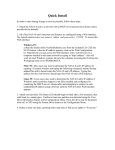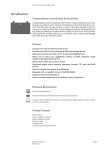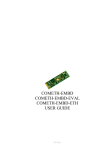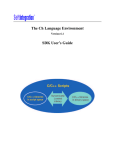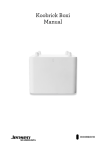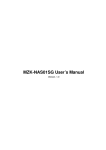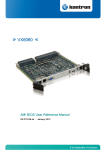Download Addonics Technologies NAS40ESU User guide
Transcript
NAS 4.0 Adapter (NAS40ESU) www.addonics.com Technical Support If you need any assistance to get your unit functioning properly, please have your product information ready and contact Addonics Technical Support at: Hours: 8:30 am - 6:00 pm PST Phone: 408-453-6212 Email: http://www.addonics.com/support/query/ Firmware v98a.5 Overview Power Connector Network Port Power LED Status LED Reset Button Storage Ports Storage Ports: eSATA (3.0Gbps) or USB (2.0). Each port supports one eSATA device and one or more USB based devices, up to 16 physical drives. Network Port: Supports 10/100/1000. Power LED: glows when unit is on. Status LED: glows steady when unit is idle, other states are dark or dim to indicate a problem, slow or fast blinking between dark and bright or dim and bright to indicate the unit is busy. Network Cable Power Supply (U.S. Version Shown) 1 www.addonics.com Technical Support (M-F 8:30 am – 6:00 pm) Installation Network Connection The NAS unit is factory configured for dynamic IP addressing (DHCP client). Connect the unit to a network (router or switch) where DHCP is supported. Static IP may be assigned later after initial setup. Storage The NAS unit does not support FIS switching for port multipliers, therefore any eSATA devices must be a single drive or a RAID array. Also, through the use of USB hubs, up to a total of 16 physical storage devices may be connected, also counting any eSATA drives. One SATA port multiplier in JBOD mode may be connected using USB; however, with more than one such port multiplier connected only one will function – others will not be recognized at all. Each physical unit may be formatted with up to 4 individual partitions using a Master Boot Record (MBR), or up to 15 individual partitions using a GUID Partition Table (GPT). Supported file systems are: FAT32, ext2, ext3, ext4, XFS, and NTFS. The NAS unit will by far provide the best performance when using the XFS file system. NOTE: Initializing a drive with MBR is limited to drives less than 2TB in capacity with up to 4 partitions total. For drives greater than 2TB in capacity or if more than 4 partitions are desired, the drive must be initialized using a GPT boot record. NOTE: While the NAS unit does support storage with several Terabytes of capacity, USB hard disks greater than 2TB may not be compatible. For best results, connect an eSATA drive in cases where a storage device greater than 2TB of capacity is desired. The NAS Unit Boot Process Upon connecting power the unit, the status LED will blink at first between bright and dim, then remain dark for a few moments, then begin to blink between bright and dark for a while and finally settle down to glowing steadily. Once this pattern is complete the unit is ready to communicate. This process normally takes about a minute or less, but may take longer depending on the complexity of the configuration, storage and LAN connections. With the 240 possible file systems, booting may take several minutes or longer. Resetting the NAS Should a problem arise with the NAS unit or its configuration, the unit may be reset simply by turning the unit off, then back on after a few moments. If this doesn't clear the problem, the unit may be returned to its factory configuration by gently pressing and holding the reset button between the power and LAN connectors until the Status LED blinks slowly, then rapidly. After releasing the Reset button while blinking slowly there will be no changes. After releasing the button once the Status LED blinks rapidly, the Status LED will continue to blink for a while, and may possibly glow steadily for a while as well. Eventually it will begin the boot process, beginning with blinking between bright and dim. Once the boot process is complete and the LED is glowing steadily again, all settings will have been cleared and the unit is ready to communicate with all settings reset to the factory default – including the network and device name settings. If the process appears to become stuck or takes too long to complete, you can try disconnecting power, then reconnect and after the Status LED blinks bright and dark a few times, try the Reset button again. Phone: 408-453-6212 Email: www.addonics.com/support/query/ 2 Connecting to the NAS Unit All of the NAS unit's functions and features are configured using a Web Interface. Once the hardware is installed, access the Web Interface with a web browser on a computer attached to the same network by typing in “http://addnas” - this will work on most Windows systems. Be sure the computer accessing the NAS unit has the Workgroup name set to WORKGROUP. Operating systems other than Windows may need to access the web interface by typing in the NAS unit's IP address instead of “http://addnas.” Mac: Mac users may determine the NAS unit's IP address by opening a Terminal window and typing the following command: smbutil lookup addnas This utility should return the NAS unit's IP address. Linux: Linux users may find the NAS unit with the Samba client. The packages samba and samba-client must be installed, and the Linux Firewall must be configured to trust “Samba Client” (inbound ports 137/udp and 138/udp). Having met these requirements, open a Terminal window and type in the following command: nmblookup ADDNAS If the above methods do not work, determine the NAS unit's IP address by examining the DHCP server's clients table. Usually this means connecting to a home router's web interface. Refer to the router's User Guide for details on how to locate the DHCP Clients table. Many routers list the hostnames for DHCP clients in the table, if so the NAS unit's default hostname is ADDNAS. Otherwise, you may have to try each IP address listed. Initial Setup Once you have connected to the Web Interface, the Initial Setup page will appear: Click Next, then a dialog will appear requesting the Administrator login. The default username is "admin" and the password is "123456" (without the doublequote marks). Next, set a custom password for the admin account. The admin account name may also be changed. 3 www.addonics.com Technical Support (M-F 8:30 am – 6:00 pm) Next, set up the Date and Time. Choose a city nearest you in the same Time Zone and be sure the Date and Time are correct. Finally, review and confirm the settings: After clicking on the Update settings button, Initial Setup is complete. Phone: 408-453-6212 Email: www.addonics.com/support/query/ 4 Sharing Files Using the NAS Unit After the Initial Setup is complete and storage is attached, the NAS unit's basic configuration is complete; however, it will not immediately start sharing the storage until at least one share is configured. The NAS unit can share an entire drive, a folder on a drive that has existing content, or create a new folder to share. Refer to the section titled “Add A Shared Folder” for details. SMB (Windows Sharing) Windows: Connecting to the NAS for direct file access through Windows Explorer is very similar to sharing files between Windows systems. Typing “\\ADDNAS” into the address bar (or the NAS unit's hostname if changed from the default, or the NAS unit's IP address) is the easiest way to gain direct access quickly. After pressing Enter, the Explorer Window should show a list of the shares available. Opening any of the shares is like opening any other folder, except when accessing a share for the first time, Windows may request a username and password for access to the share (unless “Everyone” permissions have been changed from the default setting of NONE). Entering a valid username and password will open the folder with appropriate access rights for that user. If “NONE” permissions are set for that user on that share, Another username and password prompt will appear. After connecting to a share, Windows will use the same username and password for all connections until the Windows user logs off of Windows. Mac: on the Finder's Go menu choose “Connect to Server...” then in the server address box type “smb://” followed by the NAS unit's IP address. The same authentication rules apply as with Windows. Linux: Use the “Connect to share...” dialog found on the Nautilus or “File Manager” menu bar, then select Windows Share for the type and complete the remaining fields for share name, username and password. Information required to complete the connection and the system's response vary from one version of Linux to another, and should be expected to work about the same way as connecting to a shared folder on an actual Windows PC. Some Linux distributions come with a File Browser package like Nautilus, and depending on the package and version, and sometimes whether or not the samba-client package is installed, you may be able to browse Windows networks like with Windows. FTP Server Anonymous login is supported with no user home directory and access to any shares with read-only or read and write access to "Everyone" for FTP. Authenticated users will have read and write access to their home folder and any other shares defined under the Sharing tab with read-only or read and write access for the user for FTP, as well as "Everyone." 5 www.addonics.com Technical Support (M-F 8:30 am – 6:00 pm) The Configuration Tab Update Admin Username and Password Changes the web interface management login. Configure User Home Directory Drive Determines which drive on the system carries the HOME directory for users. The user's home folder is useful for storing private files. If a home directory is already defined it will be shown. Choose a volume and click Save. If any files exist in a previous Home directory they will be moved to the new location. Change Current Date and Time Settings for time zone, date and time. Set time zone to a listed city nearby in the same time zone. Update Device/Workgroup Names Settings for the NAS unit's network name and Windows workgroup. Default setting is ADDNAS joined to WORKGROUP. Setting the workgroup name on all devices on the same network to match is strongly recommended. The Device name is used for accessing the Web Interface as well as browsing for the shared folders on the network. Update FTP Port Number Changes the TCP Port used by the FTP server. Default is port 21. Note that some FTP clients will not be able to connect on alternate ports. Phone: 408-453-6212 Email: www.addonics.com/support/query/ 6 View Current Network Configuration Displays details about the NAS unit's current network settings. Includes device and network names as well as TCP/IP settings. Configure the Network Settings Starts the network configuration wizard. Choosing Automatic will configure the NAS unit as a DHCP client and the configuration wizard will skip to the end. Choosing Manual configuration will proceed to Step 2. Step 2 configures the NAS unit's static IP address and subnet mask. To choose a working static IP address, make sure you meet these criteria: 1. The subnet mask must match the rest of the network exactly. 2. The IP address must match the router's IP address exactly where the subnet mask is "255." 3. The IP address cannot end in 0 or 255. 4. The IP address must not match any other system on the network, including the router. 5. The IP address should not be within the DHCP server's client pool. 7 www.addonics.com Technical Support (M-F 8:30 am – 6:00 pm) The next step is to configure network connections. The gateway is usually the internal IP address for the router the NAS unit is connected to. DNS entries are usually the same as used by the router's external network configuration (determined by your ISP). Setting an NTP server will synchronize the NAS unit to a time server, usually on the Internet. This can be a name or IP address. Use the keywords “free NTP servers” on your preferred search engine if you wish to configure this feature and don't know of a server you can use. When the wizard is complete by either choosing Automatic in Step 1 or completing Steps 2 and 3, a confirmation page will appear. Clicking the Finish button will apply the settings. View Drive Information Displays details of all connected drives. If network shares are configured for drives that have been disconnected, those drives will also appear in this list as unavailable. Device: The letter after “sd” is the drive's letter, in order of when the drive was first encountered by the NAS unit. The number at the end of the device label is the partition on the drive, in order of the drive's partition map. Vendor: The drive's manufacturer. Model: The drive's model number. Mount Point: Used by the NAS unit internally. Also referenced in other areas when selecting a “volume.” Type: The file system the partition is formatted with. NOTE: in this column, FAT32 is called “vfat,” NTFS is called “fuseblk.” Size: The total space of the partition. Used: Space in use on the partition. Available: Remaining space available on the partition. % Used: Percentage of the partition space in use. Phone: 408-453-6212 Email: www.addonics.com/support/query/ 8 View User Samba and FTP Login Information Displays a list of open sessions for file sharing of Windows sharing and FTP. The login username, the computer's hostname and IP address are listed for each session. Format Drive Formats a specific drive using a choice of ext3 or XFS file systems. Caution: this function destroys data. Choose a drive to format. If the drive is greater than 2TB in capacity choose the GPT boot record, otherwise choose MBR. Finally, choose Linux EXT3 or Linux XFS for the file system. After clicking Format Drive, the format utility will request confirmation. NOTE: For highest possible performance, use the XFS file system. After clicking “Yes, I'm sure,” the format utility will create and prepare one partition on the selected drive, using all space on the disk. A page will load next confirming the format is in progress. This page updates once every minute. Once formatting is complete, the page will change to state it is done. Click any of the tabs above the message to perform other tasks. If desired, this can be done before formatting is complete; however, the drive being formatted cannot be used until formatting is done and there will be no further notifications. Safely Remove Drive Closes all pending I/O to a specified drive then “unmounts” it for removal. Caution: best practice is to notify any and all users this will be done before proceeding to prevent data loss. Abruptly removing a physical drive without notifying users or using the Safely Remove Drive function may cause file system corruption and loss of data. Backup Internal System Configuration Information Saves or restores all of the NAS unit's settings using a specified drive. Select the volume desired for backups. If backups exist on that volume they will be listed under Backups, with comments if present. To create a backup, add a backup comment if desired then click Create Backup. To restore an existing backup, select the desired backup and click Restore Selected. The currently selected backup may also be deleted using the Delete Selected button. All three functions will request confirmation before proceeding. Reboot Restarts the NAS unit. Caution: best practice is to notify any and all users this will be done before proceeding. Upgrade the System Firmware In the case of a firmware update release, this utility applies the update. Update will not proceed unless only one volume (one partition on one drive) is present. Instructions on updating firmware are provided with the firmware update. Caution: All of the NAS unit's settings may be lost in the process of applying firmware. Make sure to notify any and all users this will be done to prevent data loss and use the Backup Internal System Configuration Information utility before proceeding. 9 www.addonics.com Technical Support (M-F 8:30 am – 6:00 pm) The Sharing Tab User Management Shows current list of known users on the NAS unit. To delete a user, click the “Delete” link next to that username, then confirm. To change a user's password, select the username just above “New Password,” then enter the new password into the “New Password” and “Confirm Password” fields and click “Change Password.” To create a new user account, click “New User,” then enter the new username and the initial password in the “New Password” and “Confirm Password” fields. If shared folders are defined on the system, select the default permissions granted to the new user for each share. Add A Shared Folder Creates a new folder and shares it on the network. This function has several steps. The first page introduces the wizard. Click “Begin Wizard” to proceed. Phone: 408-453-6212 10 Email: www.addonics.com/support/query/ Step 1 is to select the volume (file system) the share will be using. Each volume listed is a partition, described as a “Device” and “Mount Point” as shown on the View Drive Information page. Choose the desired partition and click NEXT. Step 2 is to define the actual share. To create a new folder and share it, type a name into “New Shared Folder Name” and click the NEXT button directly beneath it. To share an existing folder, select it from the “Existing Folder” pull-down and click the next button directly beneath it. To share the entire partition, Type a name for the share into the “New Shared Folder Name” and click “Share Entire Disk.” New Share names and Existing folders must be named according to these rules: 1. The name must begin with a letter. 2. The name must be upper or lower case letters or numerals only. 3. The name may not have any “special characters” - punctuation, symbols and spaces are all invalid. 4. The name must be unique, without regard to upper or lower case in the names. For example, a NAS unit with a share called “Share” may not add a new share called “Share” or “SHARE” or “share” - not even on a different drive. 5. If the name matches an existing folder on the selected volume, it must match exactly, with respect to upper and lower case. In other words, You may create a share called “User1” if there is already a folder called “User1” on the volume; however, you may not create a share called “User1” on a volume that has an existing folder called “USER1” or “user1,” this will produce an error. NOTE: An “Entire Disk” share may not be created on a volume that has folder shares, and folder shares may not be created on a volume that already has an Entire Disk share. 11 www.addonics.com Technical Support (M-F 8:30 am – 6:00 pm) Step 3 is to set the security options for users. A permission level for “Everyone” as well as each user defined on the NAS unit is listed, with settings for the SMB and FTP servers. There are three levels of permission: Full, Read Only, and None. Full permission allows full access to the share: reading files, creating new files, renaming, overwriting or deleting files is all permitted. Read Only permission allows the client to access the files and read them, but will not be permitted to write anything to the share. “None” permission prohibits all access. A share will not be visible to users with “None” permissions set. The “Everyone” setting defines the minimum permission for the share. If “Everyone” is set to “Full” for the share, all users are also automatically set to “full” regardless of how their permissions are set. If “Everyone” is set to “Read Only,” Users may be granted Read Only or Full access to the share – any users set to “None” for the share are automatically set to Read Only instead. If “Everyone” is set to “None,” then users may be granted any permissions. Using shares with Read Only or Full permissions set for “Everyone” will not require username or password if the client has not already given them using SMB. On FTP, “Everyone” permissions relate to the “Anonymous” user. Rename A Shared Folder Changes the name of the directory as well as the share name for an existing shared folder. Select the share to change and type in a new name, then click “Rename Shared Folder.” NOTE: Share names must follow these rules: 1. The name must begin with a letter. 2. The name must be upper or lower case letters or numerals only. 3. The name may not have any “special characters” - punctuation, symbols and spaces are all invalid. 4. The name must be unique, without regard to upper or lower case in the names. For example, a NAS unit with a share called “Share” may not add a new share called “Share” or “SHARE” or “share” - not even on a different drive. Remove a Shared Folder Deletes a share from the NAS unit. As a precaution this screen requires the word “yes” is typed in as confirmation. After typing “yes” into the confirmation box, click “”Remove JUST The Share, And Leave The Folder On Disk” to remove the share without destroying any data, or “Delete The Share AND The Folder On Disk” to remove the share and also delete the folder and all of its contents. NOTE: Removing an “Entire Disk” share will never destroy any data, regardless of which button is clicked. Update Security Settings Changes SMB and FTP permissions for a share for each user and the general permission for “Everyone.” Select the share to change, then click next and another page will appear with current permissions. Make desired changes and click Update to apply. Phone: 408-453-6212 12 Email: www.addonics.com/support/query/ Getting Started with MLDonkey MLDonkey is a powerful, multi-protocol Peer-to-Peer (P2P) client included with the NAS unit. The features and capabilities of this tool are beyond the scope of this user guide, the steps below will show how to get MLDonkey up and running. For more information on how to use MLDonkey, visit http://mldonkey.sourceforge.net. MLDonkey Basic Setup The MLDonkey client requires one partition formatted with either ext3 or XFS. The NAS unit's format utility can format one physical unit with a single partition using all space if needed. Under the P2P/MLDonkey tab, choose the drive you wish to create the file structure on and click Save. Please note: this menu will permit setting up folders on incompatible file systems. If this is done, MLDonkey will not start or may not be able to download files. When the folder structure is set up, a page will appear stating this is done. Click the START button. NOTE: The MLDonkey setup page will create a share on the selected drive called MLDonkey. This share will be configured with “None” permissions to “Everyone” as well as all existing users. Next, a new page will appear stating MLDonkey is running. Click the link at the bottom of the page that reads “Launch MLDonkey Control Panel.” A new tab will appear in the browser with the MLDonkey web interface. If MLDonkey is not fully initialized yet, the browser may report a failure to connect. If this happens, wait about one minute and try again, either by refreshing the page or clicking a “try again” button – this step varies depending on the browser used. When first setting up, a prompt appears warning there is no password for the admin account. Click the space between the “DL” and “Input” buttons, then type the command “useradd admin” as shown, then add a password after a space. NOTE: The MLDonkey admin account is not the same account as the NAS unit's web interface admin account. It is recommended that the password matches for simplicity, but not necessary. MLDonkey will perform most of the remaining steps automatically and connect to some servers on the Donkey network. To download a file using the Donkey network, begin by clicking search, then enter some criteria and click the Search button. After a query message appears, click the "Search Results" button. To download a Torrent, on the command bar type dllink followed by a space and the full URL path to the .Torrent file and press Enter or click Input. (example: "dllink http://sampletorrent.com/path/dot-torrentfile.torrent"). MLDonkey will parse the download and add it to the download queue automatically. Files queued for download will appear in the MLDonkey share in the incoming/files folder when when complete. NOTE: this folder has read-only permissions and cannot be changed. 13 www.addonics.com Technical Support (M-F 8:30 am – 6:00 pm) Phone: 408-453-6212 14 Email: www.addonics.com/support/query/ Contact Us www.addonics.com Phone: 408-573-8580 Fax: 408-573-8588 Email: http://www.addonics.com/sales/query/



















